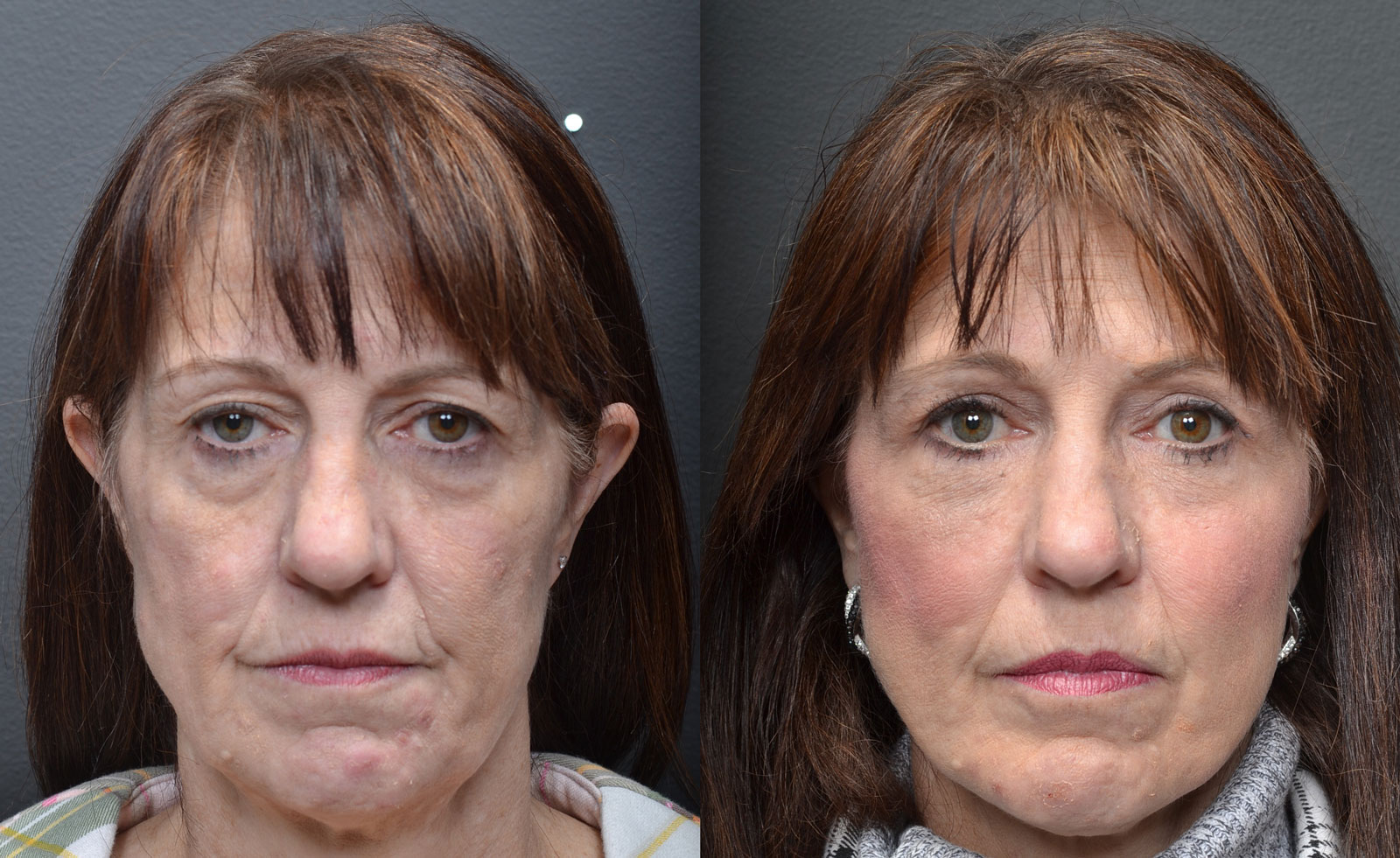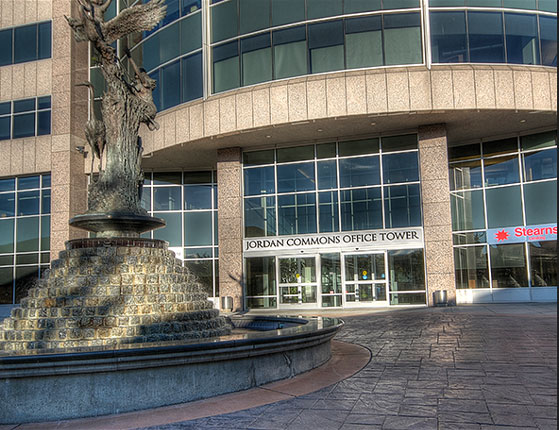Microfat and Nanofat Grafting Improve Skin Quality
- Posted on: Mar 31 2020
- Leave a response
Before and after fat grafting with facelift
By John McCann, MD, PhD
Plastic surgery such as cosmetic eyelid surgery, forehead lifts, face lifts and neck lifts can do much to improve facial appearances. Non-invasive treatments like Botox and Filler also augment facial appearances both before and after surgery. The biggest hole in plastic surgeons and cosmetic surgeons armamentarium of procedures is a reliable procedure to improve skin quality.
Cosmetic upper eyelid surgery can remove extra skin and fat. Cosmetic lower eyelid surgery can reposition the lower eyelid fat hiding the dark circle under the eyelids. Endoscopic forehead lifts, small incision face lifts, and face and neck lifts can reverse the effect of gravity on the face over time. Chemical peels and some of the less invasive laser peels can remove pigment deposits and reduce some fine wrinkles. Any of these procedures alone or in combination can achieve great results.
However, there are many changes which impact skin quality which are not addressed with any of the above procedures. One thing I have learned over the years is that if you want to reverse some aspect of facial aging you must understand what causes the face to look older. In this article we are focussing specifically on what causes the skin to look older and what can be done about that.
For nearly a quarter of a century of practice I have been waiting for a procedure that improves skin quality and now I finally have one!
Youthful skin has a property referred to as turgor. When a plant is well watered it stands tall and firm but when it is not watered it loses turgor and the stem bends and the leaves go limp and droop. We also lose turgor from our skin with age and this is mostly the result of loss of thickness of the skin. The skin has three layers: the epidermis, dermis, and subcutaneous fat. All three of these layers become less thick with age. The area of greatest loss of thickness is the subcutaneous fat. Loss of turgor and thickness of the skin plays an important role in skin aging.
Many non-invasive energy treatments have been marketed to improve skin quality. Nearly all of these treatments deliver energy to the skin in the form of light/laser energy, radiofrequency energy (RF), or sound energy (ultrasound). The intent of all of these non-invasive energy procedures is to heat up the collagen of the skin enough to cause it to shrink or tighten. Admittedly the effect of all of these non-invasive procedures is still small when compared to what can be achieved with surgery. However there is a market for these procedures as many patients have too small of a problem to justify surgery and others are adverse to the idea of surgery but are not adverse to paying the price for a small amount of tightening of the skin.
Regardless, tightening of the skin whether that be done with a non-invasive procedure or a surgical procedure is a reductive procedure. In surgery skin or fat is removed and with the non-invasive energy procedures collagen is caused to shrink. In both cases the result is reductive not additive. Neither surgery or the non-invasive energy treatments reverse the loss of thickness or add turgor to the skin. To achieve this we need a procedure that adds back something to the skin which is lost with aging.
Early on in the course of facial aging filler plays this role. Getting filler injections on a regular basis can improve the apparent thickness of the skin and give turgor to the skin. The molecule in the skin which is most important for turgor is hyaluronic acid because each molecule of hyaluronic acid can bind many molecules of water thus increasing the plumpness and turgor of the skin. Hyaluronic acid is lost from the skin with aging, and most of the fillers in use today are made up of hyaluronic acid. This is why when used properly filler can make the lips or cheeks more plump. However, as patients age the loss of volume becomes too great and they reach a point where it is just not cost effective to try to keep up with the loss of volume utilizing filler. In many patients the loss of volume is greater than 10 syringes of filler and 10 syringes of filler every 6-12 months is outside nearly every patient’s budget.
This is where microfat transfer comes into play. Microfat refers to harvesting of very small pieces of fat from a location where fat is in excess such as the abdomen or inner thigh. The fat is removed via incision sites so small they do not require stitches and then injected into the face using even smaller skin puncture sites. When we use filler we typically only address volume loss in the most obvious areas around the mouth and cheeks but when micro fat transfer is done the available fat is typically plentiful so we can address volume loss over the entire face. In a typical micro fat transfer procedure my goal is to transfer 50 syringes worth of fat to the face. Most of this will not take but about 10 syringes worth of fat will acquire a blood supply and take. This fat is injected on the temples, brows, cheeks, nasolabial fold, marionette lines,and under areas of wrinkled skin like the upper and lower lip. The greater area of treatment gives panfacial improvement as opposed to improvement only in the lips or cheeks.
The fat that acquires a blood supply will stick around for a very long time. The abundance of fat relative to filler and the duration it lasts often makes this a more cost effective treatment for patients with significant volume loss. In treating people with micro fat I began to notice some improvement not only in the apparent thickness of the skin from the addition of subcutaneous fat but also improvement in the dermis and epidermis. It was suggested by some scientists that this improvement is caused by the stem cells transferred with the fat infiltrating the skin and causing a rejuvenation effect.
This has been taken one step further with nanofat. The term nanofat refers to taking the microfat and running it through a very small bore needle such that all of the fat cells rupture and are left non viable. This process releases the smaller stem cells and the stem cells are then injected into the dermis using a device that has many microscopic size needles through which the stem cells are delivered into the dermis. Nanofat is not an injection of fat at all as it is an injection of mesenchymal stem cells. Injecting these cells into the dermis has been shown in studies to make wrinkles less prominent and even to soften scars. In my own experience the combination of microfat and nanofat does something else and that is they thicken and return some turgor to the aging skin. It is speculative on how this occurs but mesenchymal stem cells can differentiate into fibroblast and fibroblast are the cells that secrete hyaluronic acid that molecule mentioned above that is so important to restore turgor. Most important to the patient fat grafting makes your skin look younger in a way which could never be achieved with surgery or non-invasive energy treatments!
I am so sold on the benefit of this that I often do not like doing small incision face lifts unless they get the microfat and often nanofat treatment at the same time. I feel like only addressing the gravitational effects on the lower face without reinflating the face with micro fat and improving the skin texture with nanofat is just not going to give patients the result they expect from me.
Posted in: Blog




